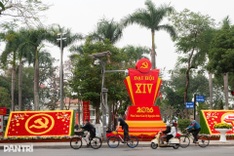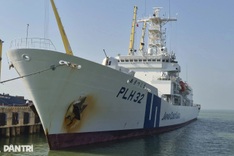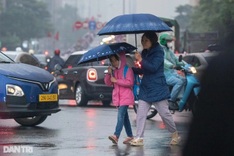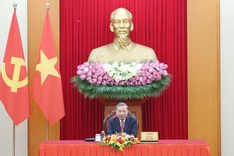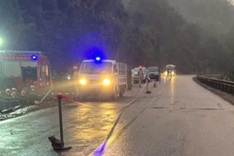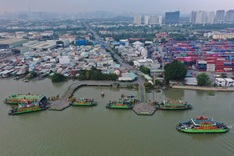Part 8 of a series on Ho Chi Minh explores the influence of his time in the US and admiration of the American Revolution had.
>>Part 1: Paris, my two worlds
>>Part 2: A journey in search of freedom
>>Part 3: Nguyen the Patriot
>>Part 4: Indochina and little emperors
>>Part 5: The rise of patriotism
>>Part 6: Finding a compass
>>Part 7: Young Ho Chi Minh with Grand Chef Escoffier
He started using the name ‘Van Ba’ for his sea journeys. On the Admiral Latouche-Tréville, his work included cleaning the kitchen, loading the charcoals, lighting the boiler, and collecting buckets of meat, fish, vegetables, and ice from the cold storage -- for the kitchen staffs. There were 800 people on the ship. Dressed in a blue seaman outfit, each day Ba worked diligently from early morning to late evening. His clothes and skin would be covered in dust, fumes, stains and sweat. For the remaining of the evening, Ba would find some quiet time to rest, then read and write, until midnight.
 |
| The Messageries Maritimes |
 |
| Chef Van Ba carrying a dessert, 1911. |
 |
| The Parker House hotel in Boston, where Van Ba was employed |
In the autumn of 1911, after a brief gardening job in the city of Le Havre, northwestern France, Ba returned to the sea with the Messageries Maritimes, going to New York. The weather in Le Havre was increasingly cold and he didn’t like working outdoors. It’s not clear what his job was during this ship journey.
Ba was always cautious and skillful and he would find a clever way of eluding and misleading the foreign authorities. What name he was using and what information he had given the US immigration upon arriving in America remain a puzzle to interested historians.
Ba worked briefly as a domestic helper for a wealthy family in Brooklyn. He was attracted to the city of Boston and soon found employment as a baker assistant at the Parker House hotel. He was later promoted to become a baker chef.
Boston is a historic city and the residents are proud of their prestigious literary history. The Parker House was founded in 1855 and became the regular meeting place for America’s distinguished writers. Among them were Emerson, Thoreau, Hawthorne, and Longfellow, who together had formed the legendary 19th century “Saturday Club” for literary discussions. This period was considered the Golden Age of American literature.
The British author, Charles Dickens, often visited the Parker House and he admired the splendor of Boston's finest hotel and its great cuisine. The Charles Dickens Room was the site of the first American reading of "A Christmas Carol", before the Saturday Club.
The Parker House was where generations of local and national politicians, including Ulysses Grant, Franklin Roosevelt, John F. Kennedy, and Bill Clinton, assembled for private meetings, press conferences, and power breakfasts.
Since the Parker House is close to Boston's theater district, many of the finest actors of the 19th century made the hotel their home away from home. These included Charlotte Cushman, Sarah Bernhardt, Edwin Booth, and his brother John Wilkes Booth. John Wilkes, the matinee-idol, was seen practicing his pistol near the hotel shortly before he assassinated President Abraham Lincoln.
During the 20th century, many stage and movie stars, from Joan Crawford, Judy Garland, and William Boyd, to Adam ‘Batman’ West, Kelsey Grammer, and David Shiner, also made the hotel their home.
The Parker House’s kitchen was renowned for its American cuisine. While Van Ba was the baker chef, he would have made the classic Parker House rolls daily. The Parker House was also credited for its techniques to perfect the Boston cream pie and the lemon meringue pie. Ba would have mastered the pie making skill here as well. On the hotel’s website, it states, “The kitchen of the Parker House has made Americana culinary culture a mainstay, with talented bakers who invented the famed Parker House roll. Parker's has also been the training ground for internationally known chefs.”
While living in Boston, Ba often traveled by train to Harlem, a major African-American residential area in New York. He attended meetings organized by Marcus Garvey, the first African-American who led a political movement against racism. Ba had observed the behaviors of the Ku Klux Klan and was horrified at America’s hatred and persecution of the Blacks. Having earlier seen and admired the Statue of Liberty at New York harbor, this shocking experience of racism would stay with Ba for a long time. He would write about racial discrimination as an eyewitness, in vivid details.
Ba met some Korean nationalists in Boston and he felt most sympathetic towards them. Korea was still under the forced “Japan-Korea Annexation Treaty”. Korean people were experiencing profound suffering. Attempting to destroy their culture, the Japanese rulers forced all families in the occupied territory to adopt Japanese surnames and the Korean language was brutally suppressed. The widespread resistance would lead to a nationalist movement in March1919. Ba compared Korea’s situation to that of Indochina. His first published article on the subject was “Indochine et Corée”, in Le Populaire of September 1919.
From Boston, Ba sent a postcard to Phan Chu Trinh, who was living in exile in Paris. Ba also wrote to his father. He worried that his father’s health was deteriorating. When Ba met again a ship captain at the port of New York, the captain offered to forward a letter from Ba, addressed to the Résident Supérieur in Hue. Ba asked this official for permission to set up a system for sending money to a bank in Indochina for his father. Ba did not know that his sister had been detained and his father was no longer in Hue. Both were under surveillance for their suspected underground activities against the French regime.
With his love of reading, Ba spent a lot of time in the reading room of the great Boston Public Library near Chinatown. Ba read about the American Revolution in 1776 and was deeply impressed with the Declaration of Independence. His knowledge of English was still limited. However, he was fluent in Chinese and was able to understand the full English texts with help from his Chinese friends. Ba had his own perception of the Americans. He thought America had liberated themselves from British rules and, therefore, would be sympathetic towards Viet Nam. He was hoping the Americans would help the Vietnamese in their fight for independence from the French.
Van Ba was the only Vietnamese in Boston. He blended in with the Chinese, living with them and speaking their language. He also enjoyed going to cinemas with his Chinese friends. Several new silent films were released during 1911 and 1912 and one was about the American Revolution, titled, “Hand Across the Sea”. Ba was still in favor of America and would have seen this film.
The Parker House building had gone through extensive renovations in late 1920’s. Although the current staffs do not know the details of Van Ba’s employment in the previous kitchen nearly a hundred years before, they feel proud that he has been there. All guests staying at the hotel are also made aware of the fact that Ho Chi Minh had been a part of their establishment from 1911 to 1913. *
| *The website below contains the following facts about the Parker House: - Ho Chi Minh was a pastry chef at Parker's Restaurant from 1911-1913. - Malcolm X, then known as Malcolm Little, was a bus boy at Parker's Restaurant in the 1940's. - John F. Kennedy had his bachelor party at the Parker House Hotel. He also proposed to Jacqueline Bouvier in Parker's Restaurant. - The Parker House roll was also invented at Parker's Restaurant, and the recipe was kept secret until 1933 when President Franklin Roosevelt requested it.” (http://www.nooschi.com/2009/11/boston-cream-pie.html) |


